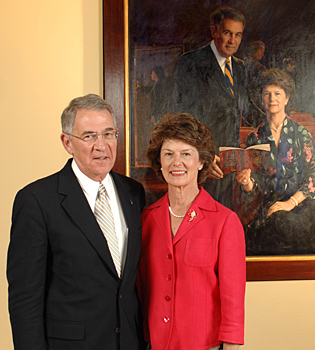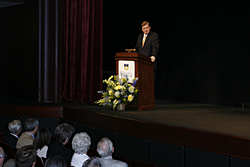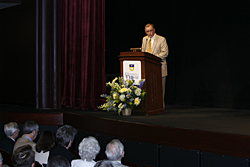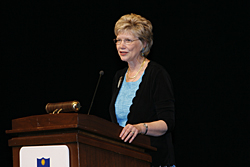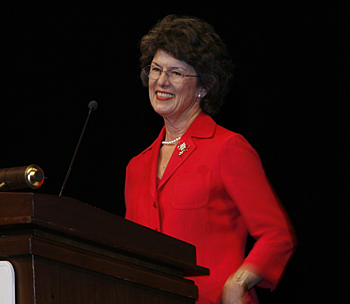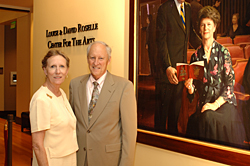Click here to see the video tribute screened at the ceremony.
3:39 p.m., June 4, 2007-- UD's new Center for the Arts officially became the Louise and David Roselle Center for the Arts at a ceremony and reception held there Sunday, June 3.
More than 350 well-wishers filled the center's Thompson Theatre to honor the 25th president of the University and his wife in the last month of their 17-year tenure at the University.
On July 1, Patrick T. Harker, dean of the Wharton School of the University of Pennsylvania, becomes UD's 26th president.
Presiding over the ceremony, Howard Cosgrove, chairman of the UD Board of Trustees, welcomed guests to an event that would “officially name this remarkable center after two remarkable people--Louise and David Roselle.”
He said the 92,000-square-foot performance and learning building has become a major crossroad for students of all disciplines and a home for theatre and music students and faculty since it opened last fall. “It is our hope that for many years to come, when we hear laughter in this building, we are reminded of Louise's embracing laugh, and, when we hear applause, we are reminded of David,” Cosgrove said.Cosgrove called on trustee R.R.M. “Ruly” Carpenter, former owner of the Philadelphia Phillies, and Debra Hess Norris, the Henry Francis du Pont Chair in Fine Arts, to offer “words of reflection” on the couple's impact on UD.
Carpenter thanked the Roselles “for the great things you've done for this University, especially for the athletics program.” He said the list is endless but includes the good will they fostered by hosting brunches before Saturday football games and receptions for athletes the University was trying to recruit. As a result, he said, UD does not lose many of the athletes it tries to recruit.
He said David Roselle has been instrumental in the construction of new facilities, such as the Bob Carpenter Center and Rullo Stadium, as well as renovations of the Delaware Field House, tennis courts, track and baseball fields and football stadium.
UD has also seen a dramatic increase in the number of athletic scholarships it has available, Carpenter said. “Delaware has 240 athletic scholarships, more than any other school in the Colonial Athletic Association,” he said.But, most of all, Carpenter said, all of these things have been done without compromising academic standards, as 87 percent of UD's athletes graduate.
Summing up David Roselle's effect on UD athletics, Carpenter borrowed a quote from Edgar Johnson, director of UD's Intercollegiate Athletics Program, who said, "David Roselle was the best president a coach or athletic director could ever ask for.”
Norris, who chairs the art conservation department and served as interim associate dean for arts and humanities in the College of Arts and Sciences, thanked the Roselles for “exceptional leadership and service.”
“The Roselles have had a significant influence on my life and the success of our department--assisting with matches to multiple million dollar grant awards, promoting our work in the preservation of our nation's cultural heritage, and supporting our efforts to respond to the needs of museums on the Mississippi Gulf Coast ravaged by Hurricane Katrina and photographic collections that suffer from inadequate protection in the Middle East,” she said.
She quoted from voice and e-mail conversations with “faculty across this campus” to present “the collective words of our faculty” describing the influence the Roselles have had on the University.The Roselles have championed the UD faculty's work across the world, she said, and faculty feel appreciated, rewarded, supported and trusted and “are all enormously proud of the University of Delaware.”
The University has prospered under David Roselle's leadership and clear sense of where the University should be heading and how to make it happen, Norris said.
One senior faculty member said early on Roselle established a limited number of clear priorities and then focused all of his attention on achieving them.
Norris said those priorities were simple--assemble a good faculty to work with good students in an attractive setting.
She said that meant raising faculty salaries so they were competitive with the most distinguished institutions in the region, creating incentives for senior faculty to remain engaged by raising funds for named and chaired professorships, providing scholarship money to attract strong students and building a physical plant second to none.
“Dave Roselle succeeded in achieving all of these fundamental goals,” Norris said.
Part of his success in enhancing the UD lifestyle came from his love of students, she said. “He refers to them as 'the kids,' and they have driven his decisions as UD president.... He has cleverly transformed situations of all sorts into learning experiences.”The UD campus is “dazzling” under Roselle's leadership, and he and Louise have made faculty, staff, UD supporters and all who visit feel welcomed at receptions, dinners and special events in their home and across the campus, she said.
“Dave and Louise, you make a wonderful team. Your magic has enriched our lives,” Norris said. “We thank you both for the care and love that you have shown each of us during these 17 years. We will carry your legacy in our hearts and our minds forever.”
After a video tribute to the Roselles prepared by Information Technologies-Media Services and the Office of Public Relations, Louise came to the podium. She introduced family members who were in the audience and thanked the Board of Trustees and everyone who spoke for “this wonderful honor and for being here tonight.”
Then the president thanked the many individuals and organizations that made the Center for the Arts possible.
He explained that there's a certain amount of equipment necessary to be a college president in the 21st century--“a grandfather clock because you're supposed to maintain traditions but keep up with the times, a crutch for those occasions when you don't have a leg to stand on and a velvet glove that conceals the iron fist that rattles the tin cup.”He personally thanked each person who contributed to the construction of the building. He said that more than $30 million had been donated to the project and gave details related to the gifts of several of the major contributors to the center.
The initial idea for this center came from students, Roselle said. "Several times a year, I put an ad in The Review that says. "Let's Do Lunch." and at one lunch meeting, some students complained that there was not enough practice space for music students. That's how the idea began," he said. "Now, if you walk on the second floor of this building, you'll find 32 practice rooms."
"Louise and I have very much enjoyed being at the University of Delaware. Recently, there have been many tributes and many nice things said to and about us. In way of reply, we believe our time was well spent, and we are grateful for having been given the opportunity to serve," he said.
The ceremony was followed by an unveiling in the lobby of a portrait of the Roselles painted by noted artist Peter Egeli. The portrait depicts them inside the Thompson Theatre.
Article by Barbara Garrison
Photos by Kathy F. Atkinson



